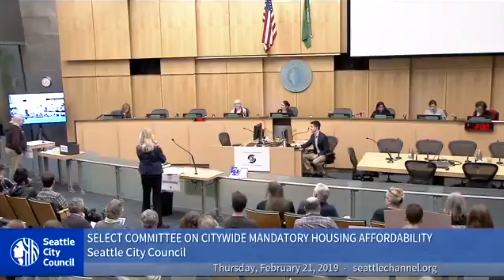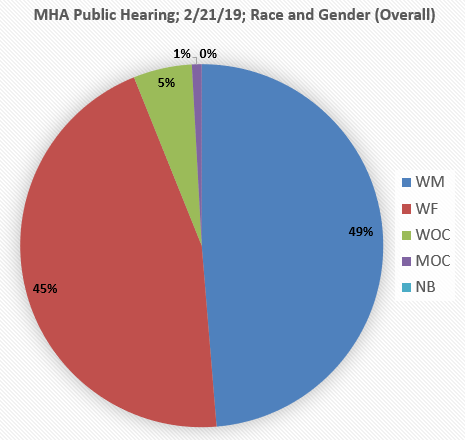#TechTrash (or: #MHA, Family Housing, and Planning for the Future)
Thursday, February 21, 2019, the Seattle City Council held yet another public hearing regarding the proposed Mandatory Housing Affordability (hereinafter “MHA”) legislation. Something like 118 people offered testimony, and 115 of those were germane to the issue at bar. (that is the worst sentence I have ever written, and I apologize).
Folks who follow me on the Twitter dot com may have seen a flurry of activity during the hearing. I attempted to tweet a summary of every person who testified, while offering my non-unique brand of cheeky commentary. During the hearing, I had feelings. Now that I have had an opportunity to sleep on it, I am doing what Seattlish taught me to do with my feelings and opinions: posting them in my own damn blog!
First, though, I want to touch on the demographic tracking I was doing. I was estimating ages, and assuming genders, and created a tracking sheet that included “PRO” for folks who were clearly 100% pro the legislation, without amendments to limit growth; “CON” for folks who were clearly opposed to the legislation, and/or advocating for amendments to essentially weaken it and disallow production of affordable homes; and “OTHER” for folks who were not speaking necessarily pro or con, but rather were speaking to specific neighborhood amendments. I further broke out speakers by how they presented (race and gender), and assumed age (using an over/under 50 split). To get an idea of the overall makeup of folks who testified:
You’re reading that right. 94% of speakers were white folks. Age-wise, it was roughly 50/50 over-50/under-50 (58 and 57, respectively). And what about where people landed? Well, that tells a story, too. Below is the breakdown of folks speaking either Pro, Con, or Other (and most of the “Other” speakers were supportive of the plan overall):
What we see here: the folks who were speaking in opposition to MHA overall were in the minority. This actually tracks with the five prior public hearings that have been held for MHA, where in all but one, opponents were a (loud) minority voice, often claiming to speak for the majority. But what did we actually hear from the speakers last night? That is where things got interesting.
First for the “OTHER” folks - the majority were either speaking in favor of the Crown Hill “density swap” (more on that later), opposing the proposed amendment to have the Boylston side of my neighborhood (Eastlake) go to midrise (a neighborhood request in Eastlake, homeowners across I-5 were opposing it claiming it may cause more noise in their neighborhood through freeway echoing, as well as disrupting their views), and exempting University Way from the zoning changes to keep the existing buildings and heights in place (I actually kinda support that idea - I am a terrible urbanist).
I actually agree that Boylston shouldn’t be zoned up to midrise, and think that E Franklin should, instead. Proximity to Eastlake Ave, the hill involved, and proximity to I-5, inform me that E Franklin makes more sense. However, given the tenor of arguments against this amendment, I’m guessing that would be opposed, as well, due to impacts on views. Arguments also included concern about impacts on existing housing on Boylston, including single-family houses (which are almost all converted to apartments), concerns about impacts on parking in my neighborhood, and concerns about lack of transit. While I appreciate the folks in the north Capitol Hill area having these concerns, this proposed amendment actually came from my neighborhood. We have parking mitigation measures. The 70 is actually a great line that runs very frequently. And LR-3 would have the same impact on the existing housing stock. There are public health implications, however, for residents of any new buildings, and that is why I support having the midrise on E Franklin rather than E Boylston. I’m not sure if that’s within the four corners of the Environmental Impact Study (EIS), but it’s my opinion.
The Crown Hill “density swap” proponents almost have me won over. I went over my issues with such a swap, and potential impact on construction costs, in my post regarding the MHA amendments. However, if the same units-per-acre can be achieved with RSL at lower heights, with a requirement of family-size for projects of 3 or more for RSL, then I’m in. If the goal is to address height and tapering, I do think it can be done with a combination of height limits and removing density limits, suggesting that we can still see homeownership options, just with smaller (square footage-wise) units, and having more opportunity to see ADUs financed for existing detached single-family houses. I’m still not 100% there, but the Crown Hill folks have done a phenomenal job working to get more growth in a way that is equitable. I look forward to seeing Central Staff return with estimates on impacts for total units and types with the density swap amendments in Crown Hill.
And as for University Way - as noted above, I’m not opposed to keeping this street (on a half-block either side) low. And I feel the same way about a few other commercial cores. Similar to Davie Street in Vancouver, BC, keeping buildings low, and value artificially low through zoning limitations, and having housing and commercial go high, I believe means more small businesses can thrive, a more walkable commercial core, and more interesting neighborhoods. Making up any loss through near-site zoning changes can readily be done. However, such a move would necessarily require more height and density increases outside of the commercial cores, and that gets politically dicey (because for some reason we have decided that dense residential belongs on arterial roads, which is dumb).
There were some other folks speaking to specific amendments, but overall it appeared that the overwhelming majority of folks in the “other” category were pro-MHA overall, with relatively minor tweaks.
Now for the cons. First, let’s take a closer look at the demographics of speakers as they land in the Pro/Con/Other categories:
Now, I could be wrong, and some of the folks testifying in opposition might be under 50. But overall, there was a clear generational divide among those testifying. And this was during a meeting that, frankly, is easier for older, wealthier, whiter folks to attend. With the advantages baked into the process, younger folks did an amazing job of turning out, and bringing their stories, bringing data, and relying on facts. As for the opposition, some recurring themes:
Tech Trash
The first person to speak against the MHA legislation, a woman named Lisa, set a tone for the opponents. Her opening remarks: she is planning on leaving Seattle because of MHA, and because of the “tech trash” that she believes is ruining our city. After talking about “amazing housing karma” that allowed her and her husband to become homeowners, she is now fighting against a modest change that may allow more families to become homeowners.
The addition to the discussion of the term “Tech Trash” was, unfortunately, a natural extension of what we have seen in our city. Laying the blame at workers in a homegrown industry, and villainizing those workers while declaring victimhood.
This carried on through the night, with opposing speakers routinely attacking developers (the same industry that made their homes and profited off of developing those homes), accusing supporters of MHA of all being paid to speak in favor, and lecturing the young people testifying in support of MHA about what they really need for housing in the future.
There was also repeated attempts to argue that the MHA legislation violates the State Environmental Protection Act (SEPA), from the same group that just lost their lawsuit challenging whether the EIS was adequate. Unsurprisingly, one speaker went so far as to essentially advocate for a cap on population growth, suggesting that Seattle put up a wall and force new residents into suburban cities in order to (wait for it) protect the environment. Of course, those of us who believe in science know that the largest contributor to greenhouse gas emissions are motor vehicles, and the most cost-effective and environmentally effective way to combat expansion of GHG infrastructure is densification of urban areas, especially near transit.
But the trees! Another common theme involved tree canopy, and concerns that more dense housing will adversely impact tree canopy in Seattle. This despite data that suggests that detached single-family housing is the largest contributor to tree canopy loss, and that, frankly, we could (and should) have more street trees, but we instead opt for more on-street parking. Of course, this also misses the forest for the trees (pun!) - suburban and exurban sprawl not only lead to more GHGs, but also more deforestation and encroachment on farmlands and critical habitat. Don’t take my word for it - that is essentially what we heard in testimony from 350 Seattle and the Sierra Club, two of the strongest advocacy organizations for environmental stewardship.
But circling back - what I found most offensive from so many speakers was the assertion that families need detached single-family housing to be “good” families, and a bedroom for every kiddo. First: I disagree. While that may be a value-set that was held by many folks in the 1960’s and 1970’s, what was clear from the speakers during the hearing: young people and young families that want to live in urban areas want housing choices that include multi-family development and attached single-family housing (think row-houses, townhomes), or shared yard housing (such as cottage housing). The “American Dream” of 1975 did not appear to be shared by folks under 50, and instead of listening to and acknowledging a desire for more housing diversity, speaker after speaker chose to lecture the younger people in the room about what they should really want. (Not to mention the ridiculous concept that some believed young families can purchase a “starter home” in neighborhoods like Wallingford).
The fact is that it is no longer 1975. It’s 2019. We are facing a climate crisis across our country. We are in the midst of an affordability crisis that is exacerbating a homelessness emergency. What has led to these: perpetuation of policies derived in the 1960’s and 70’s - car culture, gluttony, materialism - that younger generations in Seattle are clearly stating they want to change. What’s more, zoning changes alone don’t actually mean people have to leave their current residence. Hell, because of our complicated property tax system in Washington, zoning alone isn’t likely to have a meaningful impact on property tax bills year-over-year (as evidenced by property values regularly increasing at a much faster clip than property taxes).
Of course, this gets me to the recurring themes from the folks who came out to speak in favor of the MHA legislation.
We need more housing.
Speaker after speaker on the pro side came prepared with facts and data. Highlighting the disparate impact that our current housing shortage is having on low-income households and communities of color, many noted that the MHA legislation is a start, but not near enough of a change for Seattle to change course for middle-income families, and to be able to meaningfully address displacement.
Testimony kicked off with SEIU 925, talking about the challenges preschool workers face finding affordable homes near their work in Seattle. The Housing Development Consortium, a coalition of non-profit housing developers, talked about the need to infuse capital into housing development for rent-restricted units to begin catching up to a dramatic backlog of need. The Sierra Club and 350 Seattle brought delegations of volunteers speaking in favor of MHA as an environmental stewardship tool, bringing housing closer to jobs and transit, and combating the impacts of suburban and exurban sprawl. The King County Labor Council was represented, speaking out for more housing diversity for their members and workers across our region.
Individual after individual - from so-called “Tech Trash” to safe street advocates; small business owners to architects; retired homeowners to young renters - testified in support of the MHA legislation for a myriad of reasons. Some folks want to be able to continue to live in Seattle, a city that they love and in which they work. Others want more neighbors (and for those neighbors to put away their phones, as one gentleman requested). Still others want the opportunity to redevelop their homes and downsize once the kids move out, providing more opportunities for housing and new neighbors. We heard stories of folks meeting up in alleys during the snow-storm to sled and share shovels. We heard about a desire to build backyard cottages to provide permanent housing to households on the brink of homelessness (or exiting homelessness without need for wrap-around services).
One person, Brooke, brought photographs of mixed-density housing in her neighborhood, highlighting that most of the new housing that would be produced with these modest changes would be within scale of existing housing (if not the same design). Even more folks wove personal stories with data, strongly encouraging not only adoption of MHA and rejection of amendments that would limit new home opportunities, but demanding the city continue this work, and look at more robust zoning changes, particularly in the 75% of the city that is excluding housing diversity through single-family zoning.
So, what next?
If the testimony from the most recent MHA public hearing (along with all of the previous public hearings) tells us anything, it is that the future of Seattle is going to change, and the generation that will inherit the city wants that change to be equitable, to be sustainable, and to include greater housing diversity across the city. This tracks with election results in City Council races in 2015 and 2017, and I believe it will be reinforced in 2019.
This isn’t to say some dramatic zoning overhaul is likely to happen anytime soon. While the City Council included a Statement of Legislative Intent in the budget to conduct a racial equity toolkit in order to analyze Seattle’s growth strategy, and identify a more equitable way of developing our city, to date it does not appear that the City has actually begun the scoping work necessary to prepare the budget ask to fund outreach. I wholly believe we must move away from limiting so much of the city to detached single-family zoning, but we also must be cognizant of the historic impacts of zoning, and implement such changes intentionally, with a focus on anti-displacement efforts, with tools to protect what little wealth our policies have allowed communities of color to have. Not to mention the SEPA analysis requirements.
But I believe that we are heading in a direction that rejects the concept that families only belong in large houses, and instead embraces a future with more neighbors and greater housing diversity. I expect many of the same folks who have turned out throughout this process to keep coming back opposing change. It’s going to be a long haul. But I do believe that, so long as our elected officials show courage, we are on track to make modest changes that appear bold, to legalize housing diversity, and create new ways to weave equity into growth and public investment. For now, just a few more meetings left, and this start - over four years of process in the making - will (hopefully) be adopted by the City Council.







